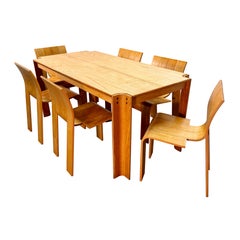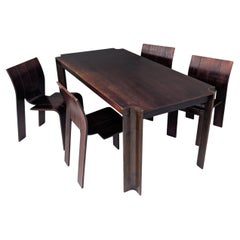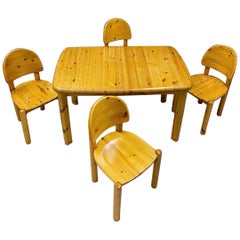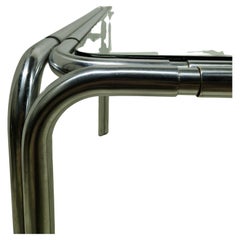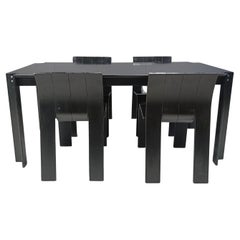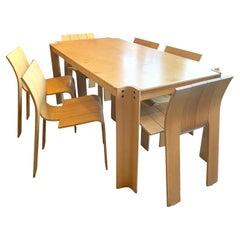Gijs Bakker Dining Room Sets
to
Height
to
Width
to
Depth
to
2
2
1
2
2
2
2
1
2
2
2
2
2
8
30
17
13
12
Creator: Gijs Bakker
Gijs Bakker ‘Strip’ ash Diningset for Castelijn the Netherlands, 1970’s
By Gijs Bakker
Located in CASTENRAY, NL
Gijs Bakker is actually best known for his jewelry. This ‘Strip’ table and 6 Chairs is one of the few known pieces of furniture that he designed.
Perhaps that is also the reason wh...
Category
1970s Dutch Mid-Century Modern Vintage Gijs Bakker Dining Room Sets
Materials
Birch
“Strip” Dining Set by Gijs Bakker for Castelijn, 1970s
By Gijs Bakker, Castelijn
Located in PRAHA 5, CZ
Designed by Gijs Bakker in the early 1970s for Dutch manufacturer Castelijn, the “Strip” dining set is an iconic expression of radical minimalism and postmodern sculptural form. Comp...
Category
1970s Dutch Post-Modern Vintage Gijs Bakker Dining Room Sets
Materials
Wood
Related Items
Rainer Daumiller for Hirtshals Savvaerk Dining Set, Solid Pine, 1970s, Denmark
By Hirtshals Savvaerk, Rainer Daumiller
Located in Biebergemund, Hessen
Outstanding combination of Scandinavian craftsmanship & design. Dining set designed by Rainer Daumiller and manufactured by Hirtshals Savvaerk Møbler. The set is made of solid pine w...
Category
Mid-20th Century Danish Mid-Century Modern Gijs Bakker Dining Room Sets
Materials
Pine
$3,567 / set
H 33.08 in W 18.9 in D 17.72 in
Mid century Bauhaus style dining set by t Spectrum, Netherlands 1960s
By Claire Bataille, 't Spectrum, Walter Antonis
Located in ECHT, NL
Mid century minimalist dining set. It consists of a square table with a glass top and 4 chairs.
The chairs have a steel tube frame with fabric covered backs and seats. They have the ...
Category
Mid-20th Century Dutch Bauhaus Gijs Bakker Dining Room Sets
Materials
Metal
$3,149 Sale Price / set
20% Off
H 27.56 in W 51.58 in D 51.58 in
Eero Saarinen for Knoll Tulip Set Including Large Oval Table and 6 Chairs 1970s
By Eero Saarinen, Knoll
Located in Buffalo, NY
Eero Saarinen for Knoll Tulip Set Including Large 78" Oval Table and 6 tulip Chairs , c.1970s,,, Classic modernist dining room set consisting of large 78" oval dining table and six t...
Category
1970s American Mid-Century Modern Vintage Gijs Bakker Dining Room Sets
Materials
Aluminum, Steel
$7,200
H 29 in W 78 in D 48 in
1970's Afra and Tobia Scarpa "Artona" burl dining table for Maxalto
By Afra & Tobia Scarpa
Located in Liberty, NY
Stunning 1970's Tobia and Afra Scarpa Artona dark walnut burl dining table made for Maxalto. Unusual square model, measuring 55" on each side , can seat eight. Good vintage condition...
Category
1970s Italian Mid-Century Modern Vintage Gijs Bakker Dining Room Sets
Materials
Walnut, Burl
Hank Lowenstein Padova vintage table and 6 chairs, from the 1970s
Located in Manzano, IT
TITLE Table and 6 chairs Hank Lowenstein Padua vintage, from the 1970s
DESCRIPTION Table with oak frame and marble top, "Padova" chairs by Hank Lowenstein. Made in Italy around 1980....
Category
1970s Italian Vintage Gijs Bakker Dining Room Sets
Materials
Marble
$3,567 Sale Price
40% Off
H 29.14 in W 58.27 in D 34.26 in
1970s MCM Russell Woodard Spun Fiberglass Outdoor Dining Set
By Russell Woodard
Located in Lake Worth, FL
For FULL item description click on More Details below.
Shipping Quote Information
The shipping quote stated in the listing was from 1st Dibs and they normally set all the costs and handle all the shipping details. However, if you let us know what 1st Dibs is quoting you and give us your zip code, we can sometimes ship it for less and get it to you faster. For a shipping quote, click on "ASK THE SELLER" under the purchase button and provide your zip code.
Offering One Of Our Recent Palm Beach Estate Fine Furniture Acquisitions Of A
1970s MCM RUSSELL...
Category
1970s Mid-Century Modern Vintage Gijs Bakker Dining Room Sets
Materials
Glass, Fiberglass
$1,036 Sale Price
30% Off
H 34 in W 24 in D 28 in
1970s Bamboo and Cane Fabric Dining Set
Located in Roma, RM
1970s Bamboo and Cane Fabric Dining Set
Product Details
Set of four chairs + table.
• Set of four bamboo chairs with cane fabric bindings.
• Bamboo dining table with cane fabric bind...
Category
1970s Vintage Gijs Bakker Dining Room Sets
Materials
Bamboo, Cane
1st Edition 'Tulip' Dining Set by Pierre Paulin for Artifort, Netherlands, 1965
By Artifort, Pierre Paulin
Located in Pijnacker, Zuid-Holland
Very rare and complete 1st edition dinner set by Pierre Paulin for Artifort, Netherlands – 1965.
This is a rare and complete 1st edition set.
The chairs swivel. The table top has been professionally refinished in the same colour. The fabric is still original but shows a lot of staining. The legs have some normal signs of age and us.
This set is extremely rare and could feature in a Paulin / Artifort museum or dedicated art show.
Reupholstery on request.
Designer: Pierre Paulin (France)
Manufacturer: ARTIFORT (Netherlands)
Country: Netherlands
Model: Tulip table and chairs...
Category
1960s Dutch Mid-Century Modern Vintage Gijs Bakker Dining Room Sets
Materials
Metal
$16,650 / set
H 28.75 in Dm 47.25 in
Dining set by Rud Thygesen and Johnny Sørensen for Magnus Olesen, 1970s Denmark
By Magnus Olesen
Located in Tel Aviv-Yafo, Tel Aviv District
Danish dining set designed by Rud Thygesen and Johnny Sørensen for the publisher Magnus Olesen in the 1970s in Denmark. Really nice work on the bentwood base with a very clean design...
Category
Mid-20th Century Gijs Bakker Dining Room Sets
Materials
Fabric, Formica, Wood
$4,162 / set
H 28.35 in Dm 55.12 in
Charles Hollis Jones Triple Arch Dining Table for the "Arch" Line, Signed
By Charles Hollis Jones
Located in Los Angeles, CA
The Arch line was created after Charles started working with the owner of the Raiders, Al Davis while designing a set of chairs for his executive office in Beverly Hills with the feeling of a football helmet, and the silhouette of a dome. The most creative arch that Charles has designed is the arch of the Le Dome table...
Category
1970s American Mid-Century Modern Vintage Gijs Bakker Dining Room Sets
Materials
Lucite
An Original & Rare Black Ash & Aluminium Arkana Circular Dining Table Set
By Maurice Burke, Arkana Furniture
Located in Reading, Berkshire
An Original & Rare Black Ash & Aluminium Arkana Circular Dining Table
With Three Black & Orange Matching Tulip Model 115 Dining Chairs
Engraved with mak...
Category
1960s British Mid-Century Modern Vintage Gijs Bakker Dining Room Sets
Materials
Chrome
$4,421
H 28.75 in Dm 41.34 in
XXL Table with Matching Chairs by L.O.V. The Netherlands, 1920s
By L.O.V. Oosterbeek, H.F. Jansen
Located in Beerse, VAN
Beautiful Dutch dining set manufactured by L.O.V. (Labor Omnia Vincit - Labor Overcomes Everything) in the mid-1920s.
It was innovator Gerrit Pel...
Category
Early 20th Century Dutch Arts and Crafts Gijs Bakker Dining Room Sets
Materials
Oak
$9,038 Sale Price / set
20% Off
H 29.53 in W 88.59 in D 27.56 in
Previously Available Items
Vintage 'Strip' Dining Room set by Gijs Bakker for Castelijn, 1970s
By Gijs Bakker, Castelijn
Located in Leuven, Vlaams Gewest
Vintage model 'strip' dining chairs with matching table. Rare set to find with table and chairs.
Designed by Gijs Bakker for Castelijn.
Beautiful ebonized plywood 'strips' which wh...
Category
1970s Dutch Mid-Century Modern Vintage Gijs Bakker Dining Room Sets
Materials
Plywood
Bakker “Strip” Dining Table and Chair Set, NL, 1970’s
By Castelijn, Gijs Bakker
Located in Austin, TX
Hard to find in the US, Dutch "Strip" dining table and chair set by Gijs Bakker for Castelijn. Great Scandinavian Modern styling with bentwood construction in natural finished ash. ...
Category
1970s Dutch Mid-Century Modern Vintage Gijs Bakker Dining Room Sets
Materials
Ash
Gijs Bakker 6 Strip Chairs and Dining Table Dining Set, 1970s
By Castelijn, Gijs Bakker
Located in Den Haag, NL
Dutch classic designed dining room set. 6 strip chairs comes with the matching table.
All black color, 1970s. Gijs Bakker for Castelijn Laminated beechwood.
Measures: Table heigh...
Category
1970s Dutch Modern Vintage Gijs Bakker Dining Room Sets
Materials
Beech
Gijs Bakker for Castelijn Dining Set
By Gijs Bakker, Castelijn
Located in Los Angeles, CA
Birch Plywood Dining Set with a Square Table and 4 Strip Chairs by Gijs Bakker for Castelijn, 1974. Set Price.
Category
1970s Dutch Vintage Gijs Bakker Dining Room Sets
Gijs Bakker dining room sets for sale on 1stDibs.
Gijs Bakker dining room sets are available for sale on 1stDibs.
